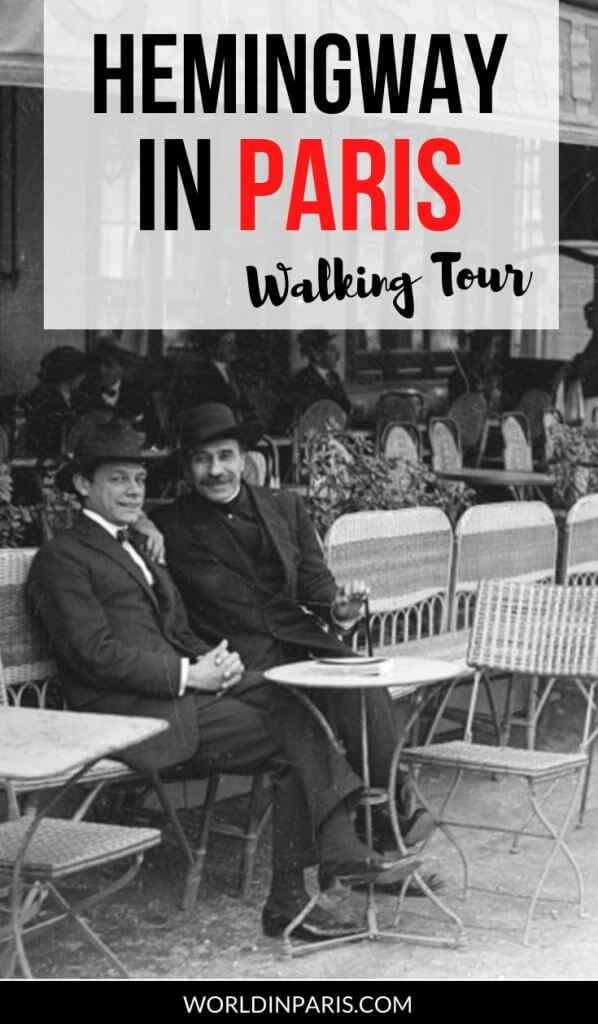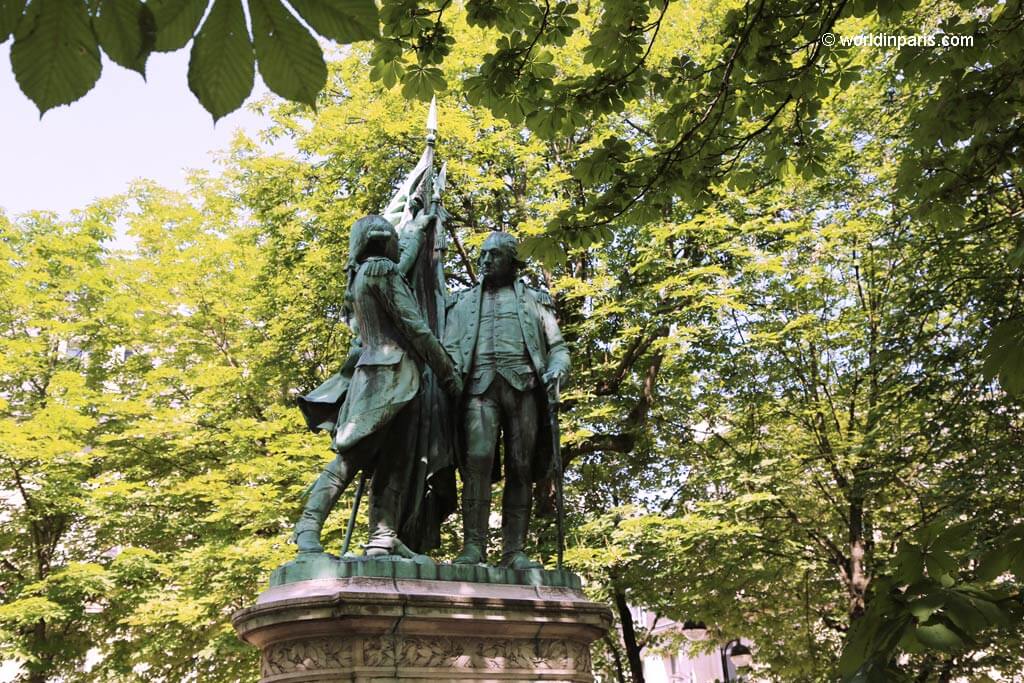Ernest Hemingway in Paris
For Ernest Hemingway, Paris was an inspiring and vital place of history, beauty, and art. Ernest Hemingway lived in Paris from 1921 to 1928 and returned several times.
In 1920 Sherwood Anderson, also a writer, urged a young Hemingway and his wife Hadley to connect with Paris, promising his writing would improve and they would meet important people. For Hemingway, who was starting as a writer in those early years, Paris was simply the best place in the world to work, and it remained the city he loved most.
A Moveable Feast is Hemingway’s classic memoir of his early days in Paris, from 1921 to 1926. In the novel, Hemingway depicts an idyllic city invested by a swarm of more or less broke artists who, like him, haunted the cafés of Saint-Germain and Montparnasse in the roaring twenties.

During this Hemingway’s Paris Walking Tour (self-guided), you will visit all the places that still remain impregnated by his memory, complemented with some funny anecdotes about Ernest Hemingway in Paris and extracts from the novel. While you will not find goatherds piping their flocks through the streets of Paris anymore, you can still get the sense of how Hemingway’s Paris must have been.
TIP: Take this walking tour of the Left Bank to discover the ‘Lost Generation’ of artists, writers, and jazz musicians who flocked to Paris between the two World Wars.
Hemingway Paris Tour (Self-Guided)
This self-guided Hemingway’s Paris walking tour is long and can last a full day. For your convenience, we split this Paris Hemingway tour into different parts, each part exploring a particular area of the city. This minimizes your walking time between places as well as transportation costs. For each area, there’s a map with our suggested stops.
This tour covers iconic places like the Cafe des Amateurs, Michaud’s Paris, and the Luxembourg Gardens. Follow this Hemingway Tour Paris step by step, or change it up to suit your individual preferences.
TIP: Check out our Paris by Arrondissement Guide to find your bearings during this walking tour.
Hemingway’s Paris – The Latin Quarter
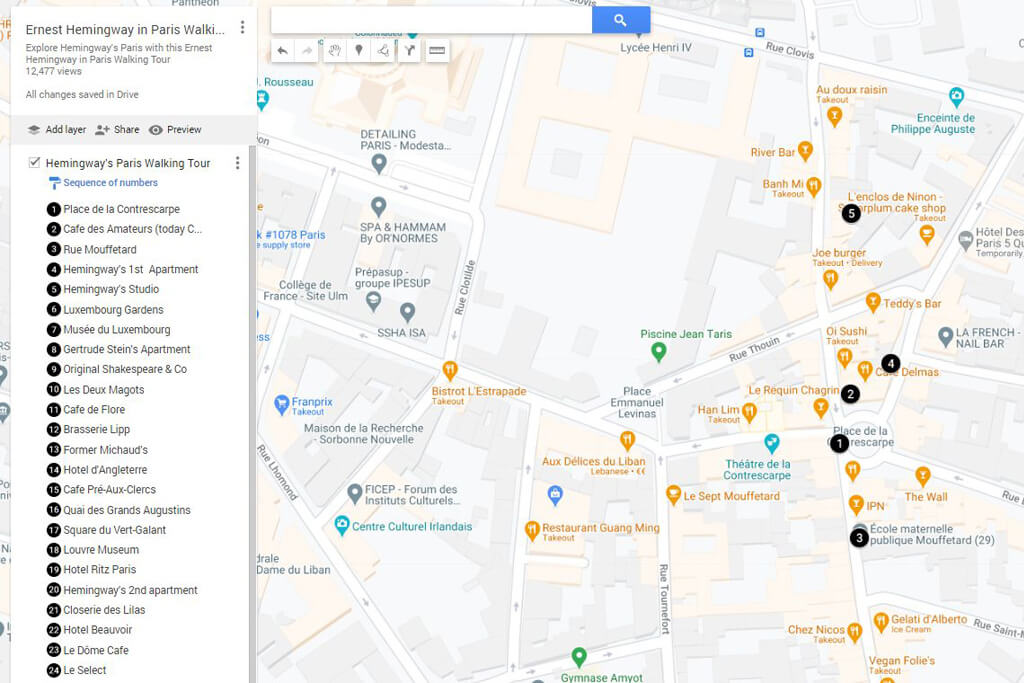
TIP: To get the most out of this Hemingway Paris Tour, we recommend getting a copy of Hemingway’s novel A Moveable Feast. You can buy this novel here.
Place de la Contrescarpe – Cafe des Amateurs

The starting point of this Hemingway walking tour Paris is Place de la Contrescarpe (#1), in the fifth Arrondissement. If there’s a place that is truly a moveable feast in Paris, this is Place de la Contrescarpe.
Place de la Contrescarpe is a lively square in the Latin Quarter with nice café terraces, perfect for people-watching with your favorite drink, and a good mix of tourists and locals.
At 2 Place de la Contrescarpe, there was the Cafe des Amateurs (#2), regularly frequented by drunkards from the neighboring houses. Hemingway wasn’t very fond of this place but started his novel A Moveable Feast with the description of the Cafe des Amateurs:
“The Cafe des Amateurs was the cesspool of the Rue Mouffetard, that wonderful narrow crowded market street which led into the Place Contrescarpe.”
The Cafe des Amateurs no longer exists, at least under that name. Now it’s Café Delmas, a popular place frequented by students from the lycées around. We prefer to have our cold beers at the Café Gaston, instead, also on this square.
Rue Mouffetard
Just in front of Cafe des Amateurs and Gaston, there’s Rue Mouffetard (#3), “that wonderful narrow crowded market street which led into the Place Contrescarpe.”
Rue Mouffetard is still one of the city’s liveliest market streets, but it has become very touristy. Rue Mouffetard is a paradise for foodies, with many specialty shops like fromageries, pâtisseries, and wine shops.
74 Rue Cardinal Lemoine

From January 1922 to August 1923, young Hemingway and his wife Hadley rented a two-room flat on the third floor (middle doors) at 74 Rue Cardinal Lemoine (#4) to begin a new life in Paris.
At that time, the Quartier Latin was an old working-class neighborhood of the fifth Arrondissement of Paris, far from the beautiful cafés and restaurants of Saint-Germain.
Hemingway wanted to spend their little store of money for travel and recreation, not fancy digs, and Hadley was as enthusiastic as he was about exploring other parts of Europe.
The apartment at 74 Rue du Cardinal Lemoine had no hot water and no toilet facilities, but it was available for only 250 francs per month (about 20$). Finally, the couple agreed that they should take it, and Paris was still wet when they moved in on 9 January 1922 …
“Home in the Rue Cardinal Lemoine was a two-room flat that had no hot water and no inside toilet facilities except an antiseptic container, not uncomfortable to anyone who was used to a Michigan outhouse.”
39 Rue Descartes
Though Hemingway initially came to Paris as a journalist for the Toronto Star, he was determined to become a proper writer. To this end, he took a room in a hotel around the corner at 39 Rue Descartes (#5) to have a quiet space for writing. Previously, this place had been a hotel where the French poet Paul Verlaine died in January 1896.
“The fireplace drew well in the room and it was warm and pleasant to work. I brought mandarines and roasted chestnuts to the room in paper packages and peeled and ate the small tangerine-like oranges and threw their skins and spat their seeds in the fire when I ate them and roasted chestnuts when I was hungry. I was always hungry with the walking and the cold and the working. Up in the room, I had a bottle of kirsch that we had brought back from the mountains and I took a drink of kirsch when I would get toward the end of a story or toward the end of the day’s work.”
From Rue Descartes, Hemingway could walk to a “Good Cafe on the Place St. Michel” – which no longer exists – or to the Luxembourg Gardens. Thanks to A Moveable Feast, we can retrace his steps:
“I walked down past the Lycée Henri Quatre and the ancient church of St. Etienne du Mont and the windswept Place du Panthéon and cut in for shelter to the right and finally came out on the lee side of the Boulevard St. – Michel . . .”
Hemingway’s Paris – Around The Luxembourg Gardens

The Luxembourg Gardens

This Hemingway tour Paris moves now to chic Saint-Germain-des-Prés neighborhood, which was not that chic at that time.
The Luxembourg Gardens (#6) is a lovely garden in the 6th Arrondissement of Paris where Hemingway often walked, especially “in the early days when we were very poor and very happy.” It seems that Hemingway walked through the Luxembourg Gardens to avoid temptation when he was too hungry:
“The best place to do it was the Luxembourg Gardens where you saw and smelled nothing to eat all the way from the Place de l’Observatoire to the Rue de Vaugirard.”
During a harsh winter, Hemingway – penniless and hungry – would sometimes hunt pigeons in the Luxembourg Gardens, snapping their necks and hiding their bodies in his son’s pram. But as often with Hemingway, the fiction may have exceeded the reality …
This beautiful garden is also where Hadley and the kid came to escape their small apartment, while Hemingway was working.
The Luxembourg Gardens is today one of the most popular parks amongst locals and an excellent place for a picnic on the grass or for an afternoon stroll. Don’t miss the pond in front of the Senate Palace or the Médicis Fountain, one of the most romantic places in Paris.
The Luxembourg Museum
In the Luxembourg Gardens Hemingway also liked to visit the Luxembourg Museum (#7). Actually, he visited the Luxembourg Museum nearly every day “for the Cézannes and the Monets and the other Impressionists that he had first come to know in the Art Institute of Chicago.”
“There you could always go into the Luxembourg Museum and all the paintings were sharper and clearer and more beautiful if you were belly-empty, hollow-hungry. I learned to understand Cézanne much better and to see truly how he made landscapes when I was hungry.”
The Musée du Luxembourg was the first French museum to open to the public in 1750 and, in 1818, it became the first museum of contemporary art. Today the Musée du Luxembourg is a popular museum amongst locals that always proposes interesting exhibitions – Check out the Current Exhibitions at Musée du Luxembourg
27 Rue de Fleurus

If the light at Luxembourg Gardens was gone, Hemingway liked to walk through the gardens and stop in at 27 Rue de Fleurus (#8), the studio apartment where his friend Gertrude Stein lived.
“It was easy to get into the habit of stopping in at 27 Rue de Fleurus for warmth and the great pictures and the conversation.”
Sherwood Anderson provided Hemingway with letters of introduction to Gertrude Stein, James Joyce, Ezra Pound, and the publisher Sylvia Beach. Hemingway wrote to Anderson: “Your letters of introduction were like launching a boat into water.”
In early March 1922, Hemingway had his first encounter with the American writer and art collector Gertrude Stein. Stein was happy to serve as a mentor for an ardent and serious young writer, and they had interesting conversations about arts, literature, and life in general.
In Hemingway’s Paris memoir, he describes his encounters with Ezra Pound and Gertrude Stein in great detail (e.g. chapter Miss Stein Instructs …). Gertrude Stein introduced him to writers and artists and to new ideas about painting and writing.
“It was like one of the best rooms in the finest museum except there was a big fireplace and it was warm and comfortable and they gave you good things to eat and tea and natural distilled liqueurs made from purple plums, yellow plums or wild raspberries …”.
Today, there’s not much to see at 27 Rue de Fleurus, but there’s a plaque on the front entrance. But you still can see Gertrude Stein’s desktop and other personal objects at Musée Carnavalet in Le Marais.
Shakespeare & Company (the Original One!)

This Hemingway Paris tour now moves south to Rue de l’Odéon. Shakespeare & Company (#9) at 12 Rue de l’Odéon was an avant-garde address and the refuge of English-speaking expatriates: the poet Ezra Pound, James Joyce, Gertrude Stein, and more.
Notorious lesbian, collector of art, and figure of the Paris of the Roaring Twenties, Sylvia Beach was a friend, mentor, and supporter of many of the key literary figures of the day living in and around the Latin Quarter. It was Sylvia Beach who published James Joyce’s classic Ulysses for the first time after many other publishers had rejected the book because of their fear of being prosecuted (a plaque marks this literary milestone today).
In A Moveable Feast, Ernest Hemingway dedicates a full chapter to Shakespeare & Company and Sylvia Beach. Beach borrowed Hemingway many books, took Hem under her wing, and pushed him to put aside journalism to devote himself to literature.
“On a cold windswept street, this was a lovely, warm, cheerful place with a big stove in winter, tables, and shelves of books, new books in the window, and photographs on the wall of famous writers both dead and living”.
Today, there’s not much to see apart from the plaque commemorating the publication of Ulysses. However, on the same street, there are a couple of ancient bookshops (Librairie Rieffel at 15 Rue de l’Odéon, Le Coupe Papier at 19 Rue de l’Odéon, and Librairie Montecristo at 5 Rue de l’Odéon) that can give an idea of how Shakespeare & Company could look like.
Hemingway’s Paris – Saint Germain-des-Prés
This Hemingway walking tour Paris continues in the neighborhood of Saint-Germain-des-Prés. After the Second World War, Saint-Germain became a center of intellectual and cultural life in Paris, with the presence of interesting writers and artists like Marguerite Duras, Jean-Paul Sartre, Simone de Beauvoir, François Truffaut, Picasso, Giacometti, and many more. All these cool people liked to wander around Saint-Germain and enjoy its particular atmosphere and a good intellectual discussion at Café Les Deux Magots or Café de Flore.

Les Deux Magots and Café de Flore

For breakfast, lunch, or a late-afternoon cocktail before dinner, the Hemingways could stroll to the Boulevard Saint-Germain and try to find a table at these two very-popular cafés. In A Moveable Feast, we find Hemingway and James Joyce having drinks at Les Deux Magots (#10).
“He asked me to drink with him and we went to Les Deux Magots and ordered dry sherry although you will always read that he drank only Swiss white wine.”
Today Café de Flore (#11) and Les Deux Magots are populated by tourists who don’t mind paying exorbitant prices to have a coffee or one of Hem’s favorite cocktails (a daiquiri or martini) in the places where he loved to hang around with his friends.
Café de Flore and Les Deux Magots are also the perfect places to enjoy people-watching on the Left Bank. They are two typical Parisian cafés where the waiters are still dressed up in the traditional black-and-white uniforms: black waistcoats and dickey bow ties and a large, white, linen napkin draped over their left forearm.
Brasserie Lipp
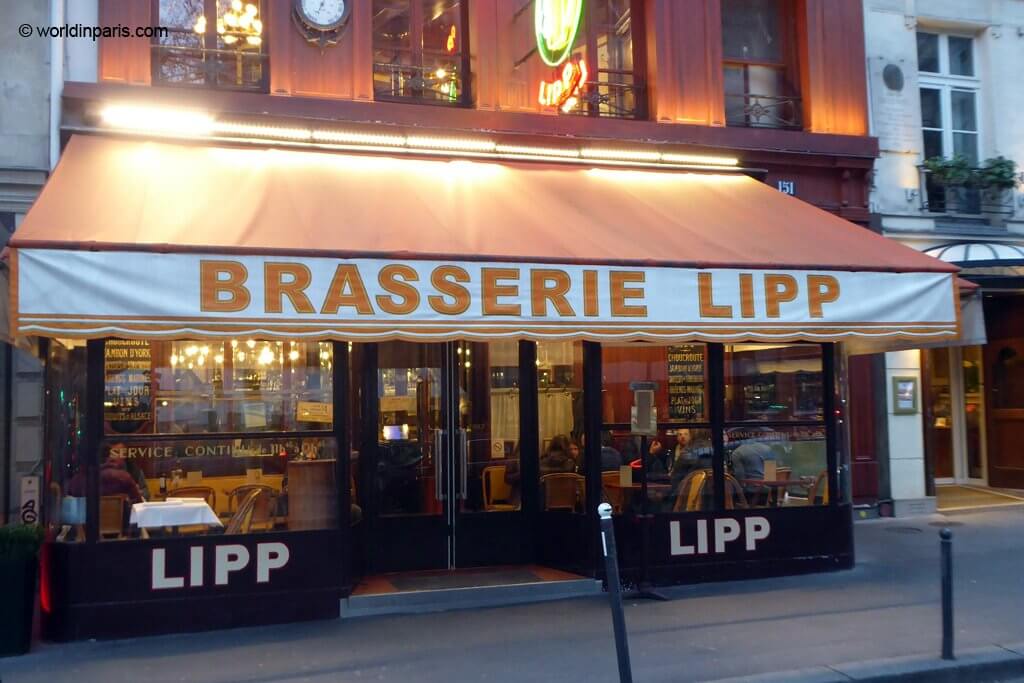
On the other side of Boulevard Saint-Germain, we find Brasserie Lipp (#13), another iconic location on the Hemingway in Paris map. Brasserie Lipp was one of Hemingway’s favorites, especially for a cold beer.
“There were few people in the brasserie [Lipp] and when I sat down on the bench against the wall with the mirror in back and a table in front and the waiter asked if I wanted beer I asked for a distingue, the big glass mug that held a liter, and for a potato salad. The beer was very cold and wonderful to drink. The pommes à l’huile were firm and marinated and the olive oil delicious.”
When Hemingway was living in Paris, the Left Bank was a cheap area to live and hang around, which is why the usually impoverished artists and writers would congregate there. Only five weeks after arriving in Paris, Hemingway wrote an article for The Toronto Star Weekly describing how cheap it was to live in the city (“Living on $1,000 a Year in Paris”, 4 February 1922).
Michaud’s Paris
An exception to this general rule was Michaud’s (#13), a fancy restaurant on the corner of the Rue Jacob and the Rue des Saints-Pères (today named Le Comptoir des Saints-Pères).
In A Moveable Feast, Ernest Hemingway reports seeing Joyce and his family eating at Michaud’s Paris. Michaud’s was an expensive restaurant for the Hemingways, but Hem and his wife treated themselves to dinner there after winning some money at the races at Auteuil or Enghien.
Hotel d’Angleterre

the Hotel d’Angleterre (#14) at 44 Rue Jacob, and more specifically room #14, was the place where the Hemingways spent their first night in Paris in 1921.
L’Hotel d’Angleterre hosted in the past the former embassy of England (hence its name) during the preparation of the Treaty of Paris. With the Treaty of Paris, signed on 3 September 1783, England recognized the independence of the United States of America.
This private mansion later became a hotel for tourists (with the name of Hotel Jacob and then Hotel d’Angleterre again), quite popular amongst many American celebrities.
The room price at Hotel d’Angleterre is today much higher than the 30$ a month (+ 2.5 francs for breakfast) paid by the Hemingways, but it is a good hotel located within walking distance of the Louvre, Notre Dame, or Jardin des Tuileries. It is always possible to book Hemingway’s room #14 – Click Here for the Hotel Latest Prices
Not far from the hotel, you can find the Cafe Pré aux Clercs (#15), one of Hemingway’s favorite cafés in Paris.
The Banks of the Seine and the Bouquinistes

The Hotel d’Angleterre is just a five-minute walk from the Seine River. Walk down Rue des Saints Augustins to the River Seine, where Hemingway spent many hours strolling through these iconic second-hand bookstalls along Quai des Grands Augustins (#16). Their collections today are just as eclectic as in the 1920s, mixed with kitsch souvenirs for tourists.
In the center of the Seine River, there’s Ile de Saint Louis, where Hemingway liked to see the fishermen in action and sometimes eat a good friture.
“I knew several of the men who fished the fruitful parts of the Seine between the Ile de Saint Louis and the Square du Vert Galant and sometimes, if the day was bright, I would buy a liter of wine and a piece of bread and some sausages and sit in the sun and read one of the books I had bought and watch the fishing.”
The fishermen left the Seine’s banks in Paris a long time ago, but it is still nice to sit at Square du Vert Galant (#17), with your feed dandling over the water, and see the riverboats sailing up and down the river.
The Louvre Museum
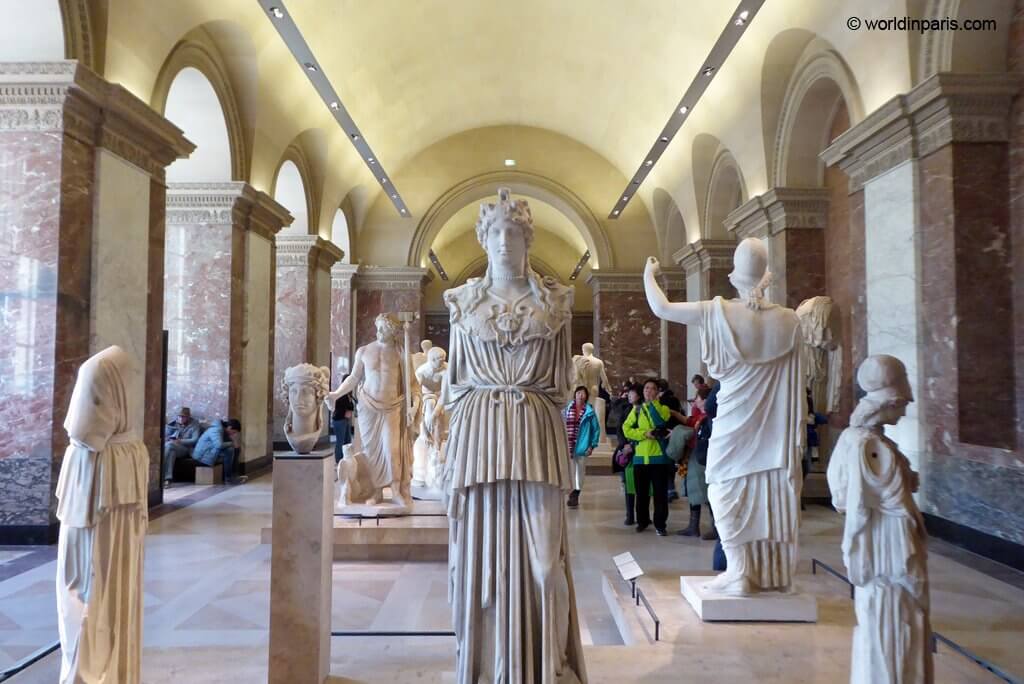
Take Pont Neuf to cross the river to the Seine’s Right Bank. Then, head to the Louvre Museum, which Hemingway knew quite well.
In A Moveable Feast, Scott Fitzgerald confided in Hemingway during a dinner at Michaud’s Paris that he was worried about the size of his penis. Hemingway took him into the toilet, studied it, and reassured him that there was nothing to worry about. Because Fitzgerald did not look that convinced, the friends ended up at the Louvre Museum, where they could wander amongst the Greek and Roman sculptures and compare.
“We went over to the Louvre and he looked at the statues but still, he was doubtful about himself. “It is not basically a question of the size in repose,” I said. “It is the size that it becomes. It is also a question of angle.”
Apart from the classical, well-proportioned sculptures, don’t miss the opportunity to explore other sections of the Louvre. After all, this is the world’s best museum! – Click here to buy your tickets to the Louvre Museum
TIP: Check out how to get the most out of the Louvre in 2 hours or less!
“Paris is the Ritz”

The Ritz Hotel (#19), located at the elegant Place Vendôme, is one of the most luxurious historic hotels in Paris. We have always seen it as the beginning of Hemingway’s Moveable Feast.
Ernest Hemingway discovered the Ritz thanks to his friend F. Scott Fitzgerald, and it was love at first sight. During his early days in Paris, Hemingway had to scrimp on his meager income for a drink at the Ritz every week. Later, when he was already a successful author, he made the hotel his Parisian home because, in his eyes, “Paris is the Ritz.” – Click Here for the Hotel Latest Prices
“When I dream of afterlife in heaven, the action always takes place in the Paris Ritz.”
In November 1956, the management of the Ritz Hotel convinced Ernest Hemingway to repossess two small steamer trunks that he had stored there in March 1928. The trunks contained forgotten remnants and many pages of notes from his first years in Paris. This material traveled from the Ritz Paris to the Finca in Cuba aboard the Ile de France in a large Louis Vuitton steamer trunk.
With these notes, Ernest Hemingway began work on ‘The Paris Sketches’ in the summer of 1957, and the sketches followed him in Ketchum, Spain, and Paris in the fall of 1959. By November 1959, Hemingway had delivered to his editor a draft of the manuscript without a title that lacked only an introduction and the final chapter. A Moveable Feast was published posthumously in 1964 with significant changes by the editors.
Today the bar at the Ritz Paris is named Bar Hemingway to commemorate its famous guest. The bar still displays his memorabilia.
Did Hemingway Liberate the Ritz at the end of WWII?
This is another legend about Ernest Hemingway in Paris which unfortunately is not true. Hemingway resumed his work as a war reporter when US troops decided to land on the Normandy coast in June 1944. Attached to the 22nd Infantry Regiment of the 4th US Division as a civilian, he was one of the privileged witnesses of the landing of 6 June, then the advances of the Allies towards the French grounds.
By mid-August, Hemingway was in Rambouillet alongside the US and French troops. Playing with his influence, he managed to meet General Leclerc, who marched in Paris a few days later. He asked him to let him immediately go to Paris with a troop so that he could be the first American to walk the streets of the capital. The general, who thought that Hemingway was crazy, rejected the idea. A resistant fighter met on the spot also remembered that the author “did not talk about anything else but to be the first American in Paris and liberate the Ritz.“
On August 25, the last day of the Battle of Paris, when most of the German soldiers still alive left the capital or were taken prisoners, Hemingway finally arrived at Place Vendôme. Accompanied by a small group of Resistance Rambolitans, he burst into the Ritz, gun in hand, determined to end the Germans who have seized his favorite hotel. “I’m coming to free the Ritz!,” he said, tumbling into the building. But the French flag was already on the roof of the hotel, and the Germans were far away. “Of course, Mr. Hemingway, but please leave your gun in front of the door,” said Claude Azello, the hotel director. After dropping his weapon on his Jeep, Hemingway returned to the Ritz Bar counter to drink 51 glasses of his favorite drink, dry martini.
Hemingway’s Paris – Montparnasse

113 Rue Notre Dame des Champs
This Hemingway tour Paris moves now to the neighborhood Montparnasse, full of iconic places related to Hemingway’s second stay in Paris.
After the birth of their first son in Canada, the Hemingways moved back to Paris to 113 Rue Notre-Dame-des-Champs (#20), above a sawmill (which is why the apartment was cheap).
The apartment had no electricity, but it was large enough for a family of three. The poet Ezra Pound lived at No. 70, and it was here where he introduced Hemingway to one of his first publishers, Ernest Walsh. This apartment was located on the southern tip of the Jardin du Luxembourg, a brief walk from Stein’s apartment.
Today the concrete-coated block is part of the Ecole Alsacienne, but the 70 Rue Notre-Dame-des-Champs is worth the visit; Hemingway’s building might have looked like this one.
La Closerie des Lilas

“To have come on all this new world of writing, with time to read in a city like Paris where there was a way of living well and working, no matter how poor you were, was like having a great treasure given to you.”
La Closerie des Lilas (#21) was Hemingway’s favorite café during his last years in Paris. During Hemingway’s second stay in Paris, he established his headquarters at La Closerie des Lilas (the café has its own chapter in the novel), located near Hemingway’s second apartment in Montparnasse.
Hemingway spent hours at the Closerie des Lilas writing. In 1925, he wrote in this café one of his masterpieces, The Sun Also Rises.
“The Closerie des Lilas was the nearest good café when we lived down the Rue Notre-Dame-des-Champs, in the top floor of the pavilion in the courtyard with the sawmill, and it was one of the nicest cafés in Paris. It was warm inside in the winter and in the spring and fall it was very fine outside with the tables under the shade of the trees on the side where the statue of Marshal Ney was, and the square, regular tables under the big awnings along the boulevard.”

Today you can sit at the front of this Hemingway café and do like Hem, “keep the statue company and drank a cold beer before going home.” Marshal Ney’s statue is still there, flourishing his sword against the enemies of Napoleon I!
Today, the Closeria des Lilas is a fancy restaurant with delicious French food and impeccable service à la française. The restaurant also has a part running as a brasserie, with a different menu and more modest prices. The last time we went there (during the week), there was live piano music.
Just beyond it, across the road, you can see the sign of the Hotel Beauvoir, where Hadley Hemingway and their young son stayed after Ernest left her for Pauline. Paris began to turn sour for all of them.
“Paris was never to be the same again, although it was always Paris and you changed as it changed,” he wrote of the break-up.
Around Boulevard de Montparnasse

Not far from La Closerie des Lilas, along Boulevard de Montparnasse, you can find Le Dôme (#23), Le Select (#24), La Coupole (#26), and La Rotonde (#25), four brasseries and American Bars well known to Hemingway and his tribe.
“The Dôme was crowded too […] There were models who had worked and there were painters who had worked until the light was gone and there were writers who had finished a day’s work for better or for worse, and there were drinkers and characters, some of whom I knew and some that they were only decoration.”

Also in this area, at 10 Rue Delambre, you can find the historic site of Dingo Bar. This is the bar where Hemingway first met Fitzgerald and the two English aristocrats on whom he based the characters of Duff Twysden and Mike Guthrie in The Sun Also Rises.
Today, Dingo Bar is called the Auberge de Venise, and it is a good place to eat Italian food. The prices on the menu are correct, so it’s an excellent opportunity to eat on the spot where Hemingway and Fitzgerald first met.

The last stop of this Hemingway Paris tour is Le Falstaff (#28), at 42 Rue de Montparnasse. It was in this beer bar that Ernest Hemingway took a shake-off one evening in July 1929.
An improvised Boxing Match at Le Falstaff
In 1929 Hemingway’s Canadian friend Morley Callaghan (also a reporter for the Toronto Star) and his wife, had joined him to spend the summer in Paris. Callaghan wanted to meet the “Lost Generation,” Gertrude Stein’s term for all those American artists who emigrated to France during the Roaring Twenties.
Their friendship ended abruptly one evening in July. The two men were at Le Falstaff when they decided to fight each other in a boxing match. They improvised a ring in the pub and named F. Scott Fitzgerald as the referee.
The latter was completely drunk and, captivated by the fight, forgot to ring the bell, so the round did not finish, and Callaghan did not stop hitting. Finally, Fitzgerald separated the two men apologetically, his clock indicating that the round had lasted 3.45 minutes instead of a minute as expected. Mad with rage, Hemingway swung to Fitzgerald:
“All right, Scott, if you want to see me getting the shit knocked out of me, just say so. Only don’t say you made a mistake”
And he stomped off to the shower room to wipe the blood from his mouth.
And there you have it, the list of places related to Hemingway in Paris. The Paris of Hemingway today may seem totally lost in time, but “There is Never Any End to Paris.” Paris is still (and it will be for a long time) A Moveable Feast!
Hemingway Tour Paris – Where to Stay
HOTEL RITZ PARIS (LUXURY HOTEL)

This is one of the most iconic 5-star hotels in Paris, and it was also one of Hemingway’s favorite places in the City of Lights (“Paris is the Ritz“). Located at elegant Place Vendôme, this is the place to go if you have the budget – Click here for the Latest Prices
HOTEL D’ANGLETERRE (MID RANGE HOTEL)

This charming historic hotel in the heart of the Saint-Germain neighborhood is where the Hemingways spent their first nights in Paris (room #14). Its location is perfect for exploring some of Hemingway’s favorite cafes and restaurants in Paris – Click here for the Latest Prices
HOTEL DES GRANDES ECOLES (MID RANGE HOTEL)

This charming hotel is located just a few steps from Hemingway’s first apartment. Nestled in a beautiful garden, it’s as if you were in the countryside! The cozy rooms take us a few decades back. Warning: this hotel tends to be sell out VERY fast! – Click here for the Latest Prices
Pin it now & read it later
